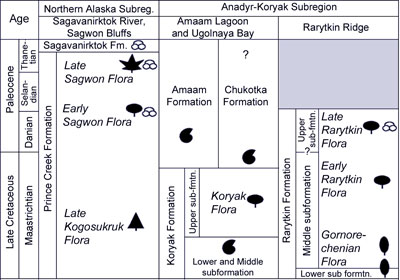Correlations
| North Pacific | AKSR-NASR | Anadyr-Koryak | Verkhoyansk-Chukotka | Okhotsk-Chukotka | N. Alaska | Yukon | Chignik |
|---|---|---|---|---|---|---|---|
| Phytostratigraphy | Images of fossils characteristic of the Type Taphoflora | ||||||
The Late Sagwon Phase of Floral EvolutionThe only taphoflora belonging to this phase comes from the upper part of the Prince Creek Formation in the Sagwon Bluffs section, an outcrop on the west bank of the Sagavanirktok River. The plant remains were collected from poorly exposed sandstones and siltstones in the middle part of the section, between coal seams nos. 3 and 4 (numbered from the bottom) in the northern part of the outcrop. This taphoflora, which is the type flora of the phase, was named Late Sagwon Flora. Based on palynological and plant megafossil data (Mull et al., 2003; Jolley et al., 2006; Moiseeva et al., 2009; Herman, 2011a; Daly et al., 2011) this flora is dated to the Late Paleocene, probably Selandian–Thanetian. The plant-bearing deposits of the Prince Creek Formation exposed in the Sagwon Bluffs above coal seam no. 3 are distinguished as Beds with the Late Sagwon flora. The duration of the Late Sagwon phase is about 4 – 5 m.y. Plant taxa present in the flora are listed in the panel to the right. The Late Sagwon Flora is characterized by a low taxonomic diversity, which is, at least in part, related to the limited outcropping of its plant-bearing layers. Angiosperm leaves Tiliaephyllum brooksense distinctly predominate in this flora. Leafy shoots of Metasequoia occidentalis (Newb.) Chaney are also abundant. Male cones belonging to the Taxodiaceae family occur, as well as shoots of Taxodium (?) and the cupressaceous Mesocyparis (?). Apart from Tiliaephyllum brooksense, angiosperms are represented by solitary leaf imprints of Trochodendroides ex gr. arctica, Archeampelos mullii, and Dicotylophyllum sagwonicum. The collection also contains several fructifications and cone scales of uncertain systematic position. Tiliaephyllum brooksense, prevailing in the Late Sagwon flora, was not found in the Early Sagwon flora, which is dominated by polymorphous large leaves of Corylites beringianus. The two floras are similar in exhibiting abundant Metasequoia occidentalis and the presence of Trochodendroides ex gr. arctica, the genera Archeampelos and Mesocyparis. Mesocyparis in the Late Sagwon flora is represented by both a different species from that in the Early Sagwon flora as well as (probably) the same species. The listed common taxa have wide geographic and stratigraphic ranges. In general, the floras differ both in the systematic composition and main dominants.
|
|
|||
 |
Correlation chart showing the relationships between the Sagwon floras and those in northeastern Russia. |
|||

